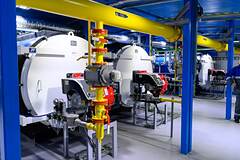The cost of gas in Europe for the first time in history exceeded $ 2,150 per thousand cubic meters

Photo: Ministry of Energy Russia / Globallookpress.com
Gas prices in Europe have reached an all-time high and exceeded $ 2,150 per thousand cubic meters. This is evidenced by the data of the London stock exchange ICE.
The January TTF index futures were at the $ 1,800 mark at the opening of the day. During the day, the indicators fluctuated and by 18:04 Moscow time they renewed the record – 2187 dollars, which became 27 percent more expensive than the day before (1716.7 dollars).
2187 dollars per thousand cubic meters – the historical maximum of gas prices in Europe
The sharp jump in prices was provoked by a decrease in the physical pumping of gas through the Yamal-Europe gas pipeline. On December 21, data from the gas transmission operator Gascade indicated that physical supplies of Russian gas via the Yamal-Europe gas pipeline running through Belarus and Poland to Germany had stopped.
The reason for this situation was Gazprom's decision not to book transit facilities. The gas does not go in the reverse direction either. The company has been reducing transit volumes since Friday, December 17th. At that time, Gazprom did not order deliveries for the next day, but at intraday trading it bought pumping volumes of 26.8 million cubic meters, which is lower than 31.4 million in previous days. On Saturday, deliveries amounted to 5.2 million cubic meters, on Sunday – 4.2 million, and on Monday – 3.8 million.
“European consumers have no choice”
Dmitry Marinchenko, Senior Director of the Fitch Group for Natural Resources and Commodities, explained to the Kommersant newspaper that the reasons why Gazprom's clients are reducing contractual selection are related to falling demand in Europe amid extremely high gas prices. In his opinion, consumers have no choice, they will have to buy fuel at inflated prices.
A significant part of all gas contracts in Europe are tied to spot or forward prices, consumers have no other choice – they have to buy gas at ultra-high prices

Dmitry Marinchenkodir, Group Natural Resources and Commodities Fitch
In an interview with TASS, Marinchenko pointed out that the price jump could have provoked a decrease in pumping through the Yamal-Europe pipeline and news of a possible cold snap. According to him, the situation remains alarming, for a comfortable passage of the winter season, Europe lacks 15-20 billion cubic meters of gas in underground storage facilities. It is also unclear to what extent Russia is ready to increase supplies if necessary, taking into account the delayed commissioning of the Nord Stream 2 gas pipeline.
Gas price forecasts
Famil Sadigov, Deputy Chairman of the Management Board of Gazprom, made a forecast regarding gas prices in the coming years. In 2022-2024, its value in the world will stop breaking new records, but, on the contrary, will begin to decline. He noted that the financial indicators of the Gazprom group in any case will have to remain at a high level, even with rather moderate export prices for fuel at the moment.
At the same time, experts do not exclude that the cost of one thousand cubic meters of fuel can reach three thousand dollars, the Prime agency reports. Asset manager of BCS World of Investments Vitaly Gromadin noted that gas prices can be anything. He cited the example of the situation in Texas in February 2021, when prices were hitting a record due to extreme frosts. Maria Belova, Research Director at VYGON Consulting, has a similar opinion.
In the spot market, which is now imbalanced under the influence of not only speculative, but also fundamental factors, any reactions are possible, including a momentary growth and up to $ 3,000 per thousand cubic meters.
Maria Belov Director of Research, VYGON Consulting
The expert pointed out that the growth trend is being shaped by a cold snap, which has led to an increase in consumption and a reduction in stocks in European storage facilities below 60 percent, as well as a delay in the launch of Nord Stream 2 and the shutdown of two reactors at nuclear power plants in France, which forced consumers to look for substitutes. energy sources, including gas.

